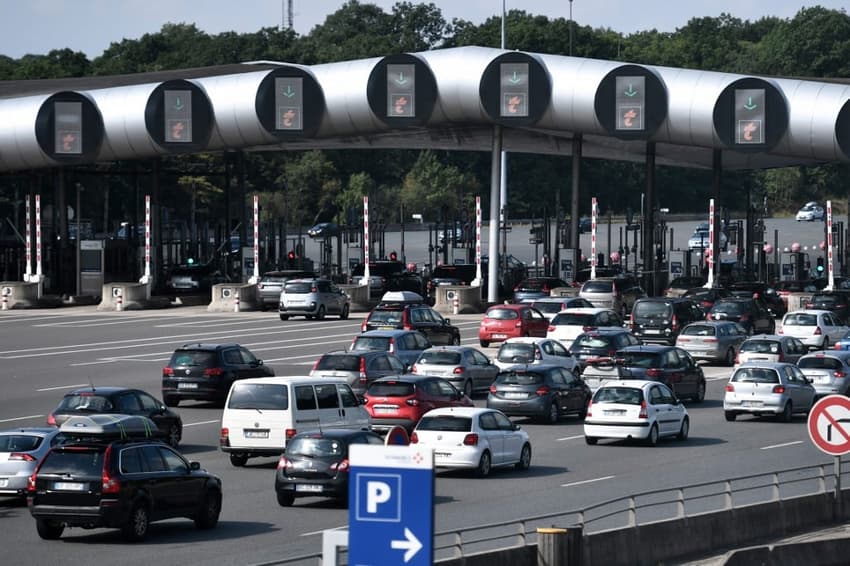Péage: Toll rates for motorists in France to increase in 2023

France's Ministry of Transport has announced that toll-fees will increase in 2023. Here is what motorists in France can expect.
With French motorists already expecting increases in fuel prices starting in January, the cost of travel on many of France's motorways will also increase in 2023.
Toll rates on the main routes across France are set to go up by an average of 4.75 percent starting on February 1st, according to an announcement by the Ministry of Transport on Friday.
These rates already rose by two percent in 2022.
While the increase is still lower than the rate of inflation (six percent), motorists in France can still expect driving to become more expensive in 2023, as the government does away with its broad-scale fuel rebate (€0.10 off the litre) at the start of January.
As of early December, the French government was still discussing plans for how to replace the fuel rebate. The Prime Minister, Elisabeth Borne, told Les Echoes in November that the government was considering a targeted, means-tested "fuel allowance" for workers who depend on their vehicles to commute to and from work.
How much will I be affected?
The degree to which drivers will experience increased costs depends largely on what kind of vehicle they use, in addition to how far you plan to drive on the toll-road.
Vehicles are broadly classified as follows:
Class 1: (Light vehicles): these are cars and minivans. This class also includes vehicles pulling trailers with a combined height of no more than 2m and a gross vehicle weight (GVW) of less than or equal to 3.5 tonnes.
Class 2: Large utility vehicles and camping cars
Class 3: Heavy goods vehicles, coaches, other 2-axle vehicles, motorhomes taller than 3m
Class 4: Vehicles taller than 3m with a GVW greater than 3.5 tonnes
Class 5: Motorbikes, sidecars, quad bikes, three-wheeled motor vehicles
The next determining factor for how significant the price rise will be depends on which company is operating the road you use, and there are several different companies that operate toll-roads in France.
Each year, toll (péage) prices in France are adjusted and re-evaluated for the following year on February 1st, following discussions between the government and the main companies that operate the French freeways. The fees are in part used for road maintenance costs.
To estimate the cost of tolls for your next French road trip, you can use the calculator on this website.
Comments
See Also
With French motorists already expecting increases in fuel prices starting in January, the cost of travel on many of France's motorways will also increase in 2023.
Toll rates on the main routes across France are set to go up by an average of 4.75 percent starting on February 1st, according to an announcement by the Ministry of Transport on Friday.
These rates already rose by two percent in 2022.
While the increase is still lower than the rate of inflation (six percent), motorists in France can still expect driving to become more expensive in 2023, as the government does away with its broad-scale fuel rebate (€0.10 off the litre) at the start of January.
As of early December, the French government was still discussing plans for how to replace the fuel rebate. The Prime Minister, Elisabeth Borne, told Les Echoes in November that the government was considering a targeted, means-tested "fuel allowance" for workers who depend on their vehicles to commute to and from work.
How much will I be affected?
The degree to which drivers will experience increased costs depends largely on what kind of vehicle they use, in addition to how far you plan to drive on the toll-road.
Vehicles are broadly classified as follows:
Class 1: (Light vehicles): these are cars and minivans. This class also includes vehicles pulling trailers with a combined height of no more than 2m and a gross vehicle weight (GVW) of less than or equal to 3.5 tonnes.
Class 2: Large utility vehicles and camping cars
Class 3: Heavy goods vehicles, coaches, other 2-axle vehicles, motorhomes taller than 3m
Class 4: Vehicles taller than 3m with a GVW greater than 3.5 tonnes
Class 5: Motorbikes, sidecars, quad bikes, three-wheeled motor vehicles
The next determining factor for how significant the price rise will be depends on which company is operating the road you use, and there are several different companies that operate toll-roads in France.
Each year, toll (péage) prices in France are adjusted and re-evaluated for the following year on February 1st, following discussions between the government and the main companies that operate the French freeways. The fees are in part used for road maintenance costs.
To estimate the cost of tolls for your next French road trip, you can use the calculator on this website.
Join the conversation in our comments section below. Share your own views and experience and if you have a question or suggestion for our journalists then email us at [email protected].
Please keep comments civil, constructive and on topic – and make sure to read our terms of use before getting involved.
Please log in here to leave a comment.